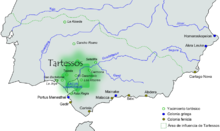Tartessian language
| Tartessian | |
|---|---|
| Region | Southwest Iberian Peninsula |
| Extinct | after 5th century BC |
| Southwest Paleohispanic | |
| Language codes | |
| ISO 639-3 | |
|
Linguist list
|
txr |
| Glottolog | tart1237 |

Approximate extension of the area under Tartessian influence
|
|
The Tartessian language is the extinct Paleohispanic language of inscriptions in the Southwestern script found in the southwest of the Iberian Peninsula: mainly in the south of Portugal (Algarve and southern Alentejo), and the southwest of Spain (south of Extremadura and western Andalusia). There are 95 of these inscriptions, the longest having 82 readable signs. Around one-third of them were found in Early Iron Age necropolises or other Iron Age burial sites associated with rich complex burials. It is usual to date them to the 7th century BC and consider the southwestern script to be the most ancient Paleohispanic script, with characters most closely resembling specific Phoenician letter forms found in inscriptions dated to c. 825 BC. Five of the inscriptions occur on stelae with what has been interpreted as Late Bronze Age carved warrior gear from the Urnfield culture.
Most researchers use the term Tartessian to refer to the language as attested on the stelae written in the Southwestern script, but some researchers would prefer to reserve the term Tartessian for the language of the core Tartessian zone, attested for these researchers with some archaeological graffiti – like the Huelva graffito – and maybe with some stelae: for example, Villamanrique de la Condesa (J.52.1). These researchers consider that the language of the inscriptions found outside the core Tartessian zone would be either a different language or maybe a Tartessian dialect, and so they would prefer to identify the language of the stelae with a different title, namely "southwestern" or "south-Lusitanian". There is general agreement that the core area of Tartessos is around Huelva, extending to the valley of the Guadalquivir, while the area under Tartessian influence is much wider (see maps). Three of the 95 stelae, plus some graffiti, belong to the core area: Alcala del Rio (Untermann J.53.1), Villamanrique de la Condesa (J.52.1) and Puente Genil (J.51.1). Four have also been found in the Middle Guadiana (in Extremadura), and the rest have been found in the south of Portugal (Algarve and Lower Alentejo), where the Greek and Roman sources locate the pre-Roman Cempsi and Sefes, Cynetes, and Celtici peoples.
...
Wikipedia
